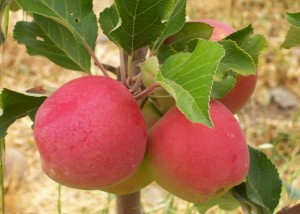Don’t let the supermarket apple selections fool you into thinking these are your only choices. There are thousands of different kinds of apples. Only a few of them are grown in large enough quantities to be produce. Some of the apples in your store are nowhere near as good as apples you never see.
Our supermarket Nob Hill over the year offers up to fifteen or sixteen different apple varieties. Most other supermarkets offer considerable fewer. Sometimes you can get different kinds at farmers’ markets or roadside stands, but even here, knowing the limited experience of their clientele, the selections often duplicate what is common available.
One solution is to grow the more unique apples yourself. Rather than duplicate the fruits that are readily available (and unfortunately also offered in nurseries), try to get varieties that are not common. Usually these are available through mail order. Here are some less common apple trees.
One of my favorite apples is Pixie Crunch. It’s a small apple, rarely larger than a crabapple. The operating word is “crunchâ€; this is one noisy apple to eat. I can never have only one of these little beauties because they are so good. Whenever I walk past the tree in season, I pick one or two to crunch on and I’ll take more on the way back. The tree is prolific, but we always want more. A common reaction from someone who tries one is, Where can I get a tree?
Two trees, developed by the PRI universities, not only have great apples, but are also disease resistant. William’s Pride, which fruits in early August, produces wonderful tasting apples and they don’t ripen all at once, so you can pick them through August. At the end of the month, the Priscilla ripens, another great apple and that keeps for three months.
The Scarlet O’Hara, also from PRI, provided a surprise for us last December. The fruit ripened in mid-September, and we had them all eaten by the end of the month, or so I thought. The apples are a little unique in flavor but very good. Then, just before Christmas, I found a solitary Scarlet O’Hara in the refrigerator, where it had been forgotten. After one bite, I immediately regretted eating them all in September. In those three months in the fridge, the apple turned from a good apple into a really great one. Now we know to save them for later.
An interesting, rare apple is the Princesse Noble. This apple originated in the 16th century in northern Germany, where it is still grown (also in Holland and France). There it is better known as Alantapfel (or d’Aunée in French). Princesse Noble is a common alternative name. The Dutch brought the apple to Indonesia when Indonesia was still their colony. There it can grow at elevations over 3,500 feet.
The apple ripens in October. The fruit is not very large. The shape is a little elongated and it is yellow with red stripes. The flesh is fine-grained, breaking but not very firm, and tends towards yellow in color. While the Princesse Noble may not be the finest dessert apple on the block, it is good, with a delicate aroma and a pleasant cinnamon-spicy taste.
Pink Pearl apple trees are often available at nurseries. They produce an apple with pink flesh. More interesting is the Niedzwetzkyana, a dark red apple with bright red flesh from Kazakhstan, the place where apples originated. These apples are great for making red apple pies and sauce. They are also good to eat if they are left on the tree to ripen longer and get sweeter.
One apple often available at farmers’ markets is the versatile Gravenstein. This variety makes a great backyard apple. The fruit ripens in August. This apple grows on a large tree and fruits so heavily that one has to cull as many as three fourths of the crop. The Gravenstein is an excellent apple for eating and cooking. It makes the best apple pies and it is our apple of choice for drying. We dry the slices by simply blowing air over them, no heat. After a week in the freezer, they will keep on the pantry shelf until the next season. For apple pies, we use apples before they are fully ripe, and we blanch the slices first for even cooking.
Gravenstein apple blossoms are sterile, so if you grow this one yourself, you will need an apple tree of a different variety to be sure of pollination. For best pollination, it is a good idea anyway to have more than one tree, unless your neighbors have a tree. The blooming times of the trees I mentioned overlap for the most part. The exception is matching Priscilla with Pixie Crunch or Scarlet O’Hara. Priscilla comes into flower in early March, while the other two only come out in early April.
Descriptions of apples may be found at various sites. Here are some.
All About Apples: http://www.allaboutapples.com/varieties/index.htm
Apple Journal: http://www.applejournal.com/use.htm
Dave Wilson Nursery: http://www.davewilson.com/br40/sales_catalogFruit.html
Trees of Antiquity: http://www.treesofantiquity.com/index.php?main_page=index&cPath=41_1
 the Dorsett Golden, which will grow without any chilling hours. The apple is golden in color, but blushes red where it is exposed to sunlight. Its flesh is crunchy, sweet tart, and has the classic apple flavor. It is also good for culinary purposes. In the right conditions, a Dorsett Golden tree will even produce two crops a year. It may have done so at Kaiapit, since most years Kaiapit mangos produced two crops.
the Dorsett Golden, which will grow without any chilling hours. The apple is golden in color, but blushes red where it is exposed to sunlight. Its flesh is crunchy, sweet tart, and has the classic apple flavor. It is also good for culinary purposes. In the right conditions, a Dorsett Golden tree will even produce two crops a year. It may have done so at Kaiapit, since most years Kaiapit mangos produced two crops.